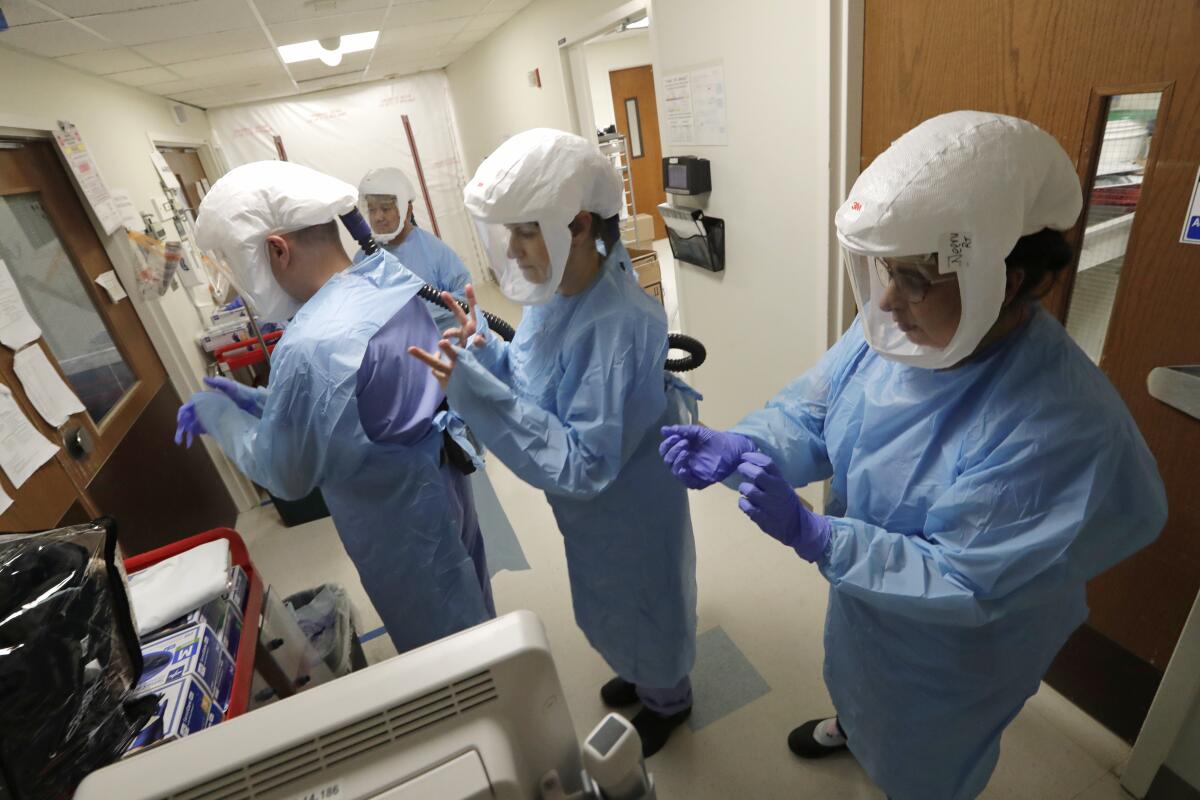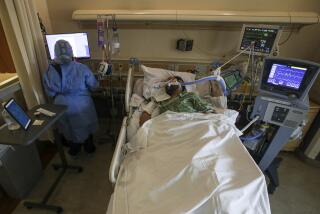Editorial: America’s poor health has put it in unique danger from coronavirus

- Share via
In the early days of the stay-at-home orders, one of the arguments used to press for a quick and nearly full reopening of the country was that COVID-19 wasn’t that dangerous. Why be so upset about the novel coronavirus, some critics asked, when flu kills more people? That talking point was squashed when, within three months of the pandemic’s start, the coronavirus killed more Americans than the last flu season did in six-plus months. COVID-19 has now killed almost 50% more Americans (about 93,000) than the highest estimate of the season’s flu toll (about 62,000).
The new argument is that the coronavirus is dangerous just to the elderly and people with certain underlying conditions. Those people should stay at home, the reasoning goes, while the rest of the nation goes about business as usual.
Certainly, people in those groups are far more likely to develop severe cases of COVID-19 and to die of the disease. But aside from the obvious — that widespread coronavirus in the larger community is also dangerous to those staying at home, because most people cannot live in an absolute bubble — this argument paints a false portrait of the nation and its residents.
The number of people facing a particular threat from COVID-19 isn’t a “just” or “only” number. It includes the obese, smokers, and people with diabetes, heart disease, lung disease, chronic and severe kidney problems, and compromised immune systems, such as cancer patients who are undergoing or recently completed chemotherapy, as well as people who take corticosteroids or other immunity suppressors for autoimmune conditions.
Less well known is whether high blood pressure is a factor. Some uncertainty also surrounds the issue of weight — so far, the Centers for Disease Control and Prevention is counting only severely obese people as high-risk. A person who is 5-foot-6 would need to weigh 248 pounds to reach that level. But one analysis found that people with less extreme levels of obesity, both younger and older, were twice as likely to be hospitalized with COVID-19 as those with healthier weights.
How many people does all this add up to? We know how many Americans have a particular health problem — about 11% of the nation has diabetes, about 14% smoke cigarettes, close to 40% are obese but only 9% severely so, and so forth. But many categories overlap. Obesity is a cause of Type 2 diabetes. Elderly people and smokers are more likely to have heart and lung diseases.
A couple of recent studies try to overcome the double-counting obstacle. A new paper published in the journal Emerging Infectious Diseases estimated that 45% of adult Americans fit at least one high-risk category. But it left out people in institutionalized settings, and we know that nursing homes have accounted for a hugely disproportionate number of deaths. A separate analysis by Kaiser Family Foundation estimated that 37% of the adult population, or more than 90 million Americans, faced a higher risk of complications if they contracted COVID-19. A little more than half of those were elderly, while 45% were people younger than 65 with one or more health problems. This report, however, left out cancer patients and counted only the morbidly obese.
Even if the high-risk population were a small portion, it would be unethical to act as though their lives and their contributions to our society didn’t matter all that much. But they are not a small corner of America. Adding the factors that were left out in the two studies, there could well be more adults with risk factors than those without.
Those who pooh-pooh the novel coronavirus’ effect on American health have often portrayed at-risk people as being at death’s door even without the pandemic — the implication being that the disease won’t shorten their lives by much. Yet two preliminary studies have estimated that those who have died of COVID-19 could have expected, on average, a decade more of life had they not been infected.
The virus has held up a mirror to the state of American health, and the reflection is unflattering. Our rates of obesity and related health problems, such as diabetes and cardiovascular illness, are far too high. Conversely, this nation has done far better than many others at reducing cigarette smoking, though that is still the leading cause of preventable death in this country. If we applied that kind of energy to reducing obesity rates — Switzerland’s rate is well less than half of ours — this would be a far healthier nation generally and one with a lower COVID-19 death rate.
Right now, if people want to think of the high-risk coronavirus population as just senior citizens and people with underlying conditions, they should consider this: That “just” population is somewhere around half of adult America and quite possibly more. They’re not a tiny fraction of America. They are America, as much as anyone else.
More to Read
A cure for the common opinion
Get thought-provoking perspectives with our weekly newsletter.
You may occasionally receive promotional content from the Los Angeles Times.










